PART ONE
OF TWO ...
2005 TABLOID WITCH AWARDS ANNOUNCED
by Thomas M. Sipos, managing editor.
[October 11, 2005]
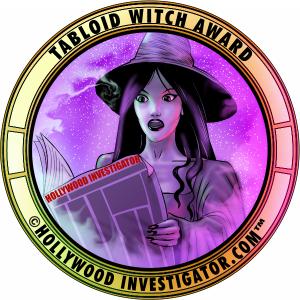 [HollywoodInvestigator.com]
The Tabloid Witch debuts this
year as the official award of the Hollywood Investigator's annual horror
film contest, now in its second year. [HollywoodInvestigator.com]
The Tabloid Witch debuts this
year as the official award of the Hollywood Investigator's annual horror
film contest, now in its second year.
Last year's winning short
film, Stiffs by Sid, secured
a DVD distribution deal after being profiled in the Investigator. Afterwards, all its featured films were screened at the World Horror Convention.
This year's films (below)
will screen at Loscon 32.in
Los Angeles's LAX Marriott hotel on Saturday evening, November 26, 2005.
The Tabloid Witch Awards
has grown, attracting many more entries than last year. Picking the
best of the best was a challenge. After reviewing winners and honorable
mentions below, we'll tell you what the featured films did right, what
pitfalls they avoided -- and what YOU can
do to win next year!
*
Best Horror Feature -- Mole
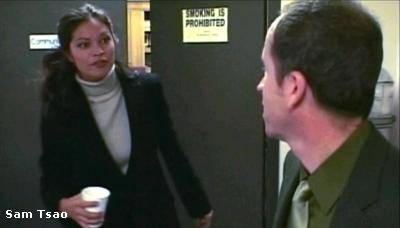 Rich Mauro and Anthony Savini's Mole evokes The
Blair Witch Project in that it's yet another gritty film about
three people who enter dangerous terrain to film a news story. But
don't imagine this is some unoriginal knock-off The cast is excellent,
the story is tense and imaginative, and the grainy videography well captures
the creepy locale -- the rat-infested tunnels under New York City. Rich Mauro and Anthony Savini's Mole evokes The
Blair Witch Project in that it's yet another gritty film about
three people who enter dangerous terrain to film a news story. But
don't imagine this is some unoriginal knock-off The cast is excellent,
the story is tense and imaginative, and the grainy videography well captures
the creepy locale -- the rat-infested tunnels under New York City.
Mole,
begins with an ambitious TV reporter (Sam Tsao) tired of flower shows,
who and seeks to do an exposé on the homeless people who live in
New
York's abandoned subway tunnels.
Recruiting a cameraman (John-Luke
Montias) and tunnel expert (James Cox), Tsao goes underground, meeting
two homeless men who tell the reporters about "mole people" -- people born
underground, living their entire lives in darkness, and are now barely
human! Urban legend or reality?
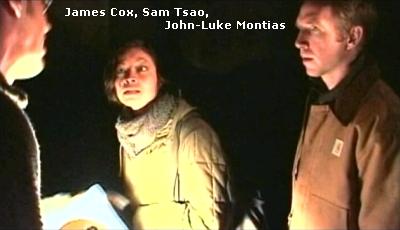 As happens to yuppies who
leave the comforts of civilization, the reporters and their guide become
lost, their lights dimming, their supplies diminishing. To worsen
matters, it seems Mole People are stalking them. Whereupon these
civilized New Yorkers revert to Lord
of the Flies/Deliverance.savagery,
fighting off the homeless, the mole people -- and each other! -- in a desperate
bid to survive. As happens to yuppies who
leave the comforts of civilization, the reporters and their guide become
lost, their lights dimming, their supplies diminishing. To worsen
matters, it seems Mole People are stalking them. Whereupon these
civilized New Yorkers revert to Lord
of the Flies/Deliverance.savagery,
fighting off the homeless, the mole people -- and each other! -- in a desperate
bid to survive.
"The idea came from the reality
that people live underneath New York for shelter, especially during the
winter," said Rich Mauro to the Hollywood Investigator. "Most homeless
people refer to them as 'moles.' My girlfriend talked about how creepy
it'd be to live in darkness underneath the biggest city in the world. I
thought,
what a great premise for a horror film!
"We shot some of the film
in a tunnel in the Bronx near Yankee Stadium. Most underground explorers
know this old subway tunnel. If you search the Internet under 'abandoned
subway tunnels,' you'll decipher where we found it. But I think it's
been closed off since. Other tunnels were shot in Brooklyn, in an
old brewery."
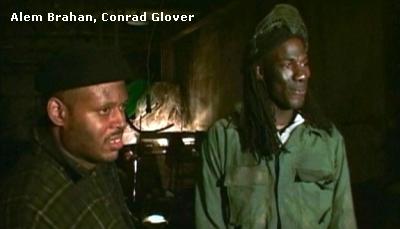 Shot in low light, Mole.has
the grainy documentary look of the Blair
Witch. And as in Blair
Witch, that gritty looks adds to the story. Shot in low light, Mole.has
the grainy documentary look of the Blair
Witch. And as in Blair
Witch, that gritty looks adds to the story.
"We shot on the Sony
PD 150," said Mauro. "But I don't recommend it. There are better DV cameras out now. I was so unhappy with the Sony
PD 150, I spent a lot of money (more than the cost of the camera)
putting a post-production 'film look' onto the film, creating a gritty,
edgy look that I'm happy with. I edited on Final
Cut Pro, a great program."
The cast is uniformly excellent,
from the leads to the bit players, offering seamless performances.
"The casting was the work
of [executive producer] Gill Holland and his company Cineblast,"
said Mauro. "I knew Jim Cox, but Gill had a list of actors he wanted,
so that's how we got Sam and John- Luke.
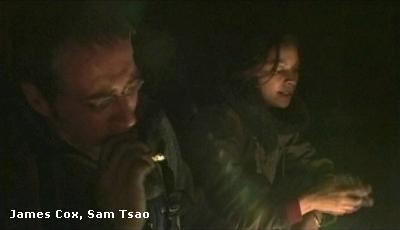 "John-Luke was nominated
for best actor at the Toronto
Online Film Festival for his role in Mole." "John-Luke was nominated
for best actor at the Toronto
Online Film Festival for his role in Mole."
Mole only runs an hour, making it not-quite-a-short, yet difficult to distribute
as a feature. (One of two one-hour features submitted to the Investigator
this year.)
"A 90-minute Mole.premiered
at the NoDance
Film Festival in Park City," Mauro said. "After distributors
passed
on it, instead of killing myself, I went to the editing room to rethink
it. When I re-cut Mole to one hour, everyone said it was a mistake and would never sell. But I chose to edit the best film, without being confined to a time requirement.
Since then Mole.has
sold in England and Germany, and got U.S. DVD distribution as Psychotic
Tendencies,
"part of a box set of horror films."
Mole.won
Best Horror Feature at the New
York Independent Film & Video Festival. Both Mauro
and co-director Anthony Savini (no relation to Tom) are NYU
film school grads. Mauro previously directed Nick
and Jane.

*
Best Horror Short -- Legion
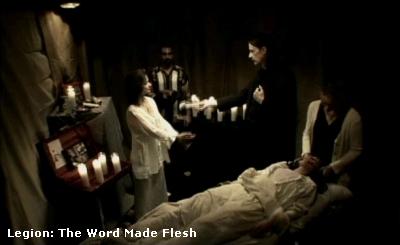 Running at 27 minutes, Legion:
The Word Made Flesh presents a somber tale of demonic possession,
the sets alternating from the darkly sumptuous to the glaringly stark. Running at 27 minutes, Legion:
The Word Made Flesh presents a somber tale of demonic possession,
the sets alternating from the darkly sumptuous to the glaringly stark.
Like the highly underrated.Lost
Souls, Legion's
beautiful photography
varies from sepia tones, to dense color saturations, to brightly over-exposed
shots, all of it aesthetically supporting the tale of a defrocked priest
and desperate mother trolling the occult underground in search of someone
to exorcise her daughter's demon.
"One impetus for Legion was a longtime friend with cancer," said filmmaker Robert Sexton to the
Investigator. "She'd spoken of the different cures and treatments
she'd undergone, how they weren't working and how desperate she was becoming."
"She'd spoken of faith healers,
gypsies, and such. I met some of them and was not too impressed. It seemed all they talked about was the money, not the cure. My friend
finally succumbed to the disease.
"But what if one of those
gypsy faith healers had worked?
"I called my friend Steve
Dandois, a talented screenwriter, and tossed the idea of charlatan faith
healers and possession. He dug it and we wrote the screenplay.
"I'm a big fan of movies
such as Rosemary's
Baby and The
Exorcist, but I didn't want to do an exorcism movie. In Legion I dealt with movie archetypes. I took pre-conceived notions of characters
and movie genres that you already know and tried to twist them into something
new -- hopefully, without you realizing what was happening until it's too
late."
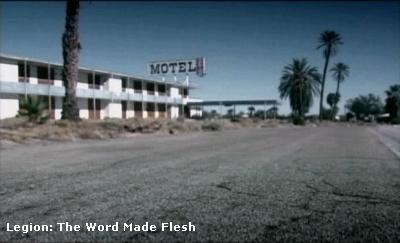 Legion is grippingly atmospheric, the motel and southwest locales supporting the
character's dreary desperation. Legion is grippingly atmospheric, the motel and southwest locales supporting the
character's dreary desperation.
"Principal photography was
shot in and around Los Angeles," said Sexton. "I took a road trip
to Mexico, Texas, Arizona and the Salton Sea for exterior shots. It was
depressing, looking for and then finding the most hellish -- but perfect!
-- locations. Those establishing shots scream of desolation and despair.
Death was in the air."
Legion was shot on several formats: 35mm, super 16, and HD video. Then during
post-production, Sexton hired Marshall Plante at The
Syndicate to color Legion. The
result is a visual feast, veering from washed-out images to those richly
saturated with warm tones. "I use them for a lot of my music videos
and commercials," said Sexton, "so Legion does.have
a high-end, commercial feel to it. Marshall did a great job."
Legion was then edited on FCP HD, sound design done
with Pro Tools. "Raz, my editor at Project4.com,
did the color matching for the insert shots as well as some of the effects
shots," said Sexton. "Raz is crazy. Good crazy, not bad crazy."
Legion was photographed
by Bobby Eras -- but Eras wasn't Sexton's first choice. Ominously,
filming began with a real-life tragedy!
"My first Cinematographer
was a DP from Chile," said Sexton. "He was fantastic. Great cinematic
style. Two days before we were to begin shooting he was was in a
terrible motorcycle accident and lost one of his legs.
"We had to put the project
on hold for obvious reasons, and in the interim I met Bobby on a music
video I was doing with Danny Carey from Tool. Bobby
and I hit it off and we decided Legion would
be perfect for both of us."
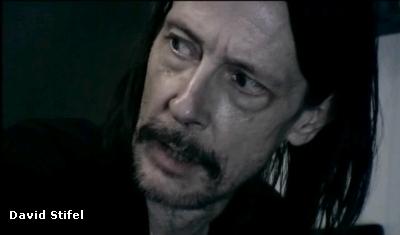 Apart from stunning visuals,
the cast is first-rate, headlined by David Stifel as a world-weary ex-priest
in search of an exorcist who can deliver. Apart from stunning visuals,
the cast is first-rate, headlined by David Stifel as a world-weary ex-priest
in search of an exorcist who can deliver.
Sexton found his actors through
casting director Marshall Moorehead.
Originally a musician, Sexton
studied film at the School of
Visual Arts in New York before moving to Los Angeles. "I then
attended UCLA
Extension programs. Bullshit seminars."
He's now
a seasoned director of commercials & music videos. "I needed
a better-paying gig [than music], and a career that was more loving, caring,
nurturing and considerate of the creative process -- like the film industry."
Sexton has directed another
film, The Disassembly Line. More
info about Legion can be found at his company's
website, Hollywood
Asylum.

* Honorable Mention
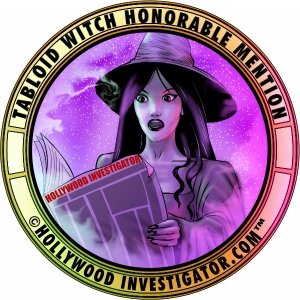 We received so many more
entries this year -- some films that would have won last year didn't
even get an Honorable Mention this year. We received so many more
entries this year -- some films that would have won last year didn't
even get an Honorable Mention this year.
This means that filmmakers
who did get an Honorable Mention have reason to be proud -- the
field was very competitive!
Shorts remain the primary
calling-card for independent and student filmmakers, and like last year,
we received more shorts than features.
In fact, all of this year's
Honorable Mentions are all shorts.
* Hollow
Abortion's guilty aftermath
is the theme of Jennifer Soemantri's Hollow,
a 9-minute short about a wealthy young couple haunted one Halloween night
by a mysterious trick or treater. Yet Soemantri said the abortion
theme grew out of the story.
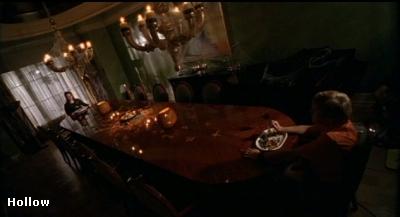 "From the get-go, I wanted
a ghost kid haunting adults in a house on Halloween," said Soemantri to
the Investigator. "From the get-go, I wanted
a ghost kid haunting adults in a house on Halloween," said Soemantri to
the Investigator.
"I wanted a plot compelling enough to allow both
adults to have an equal 'investment' in the kid. Although Paul [Wes
Armstrong] is 'out of the loop' until Esther [Lisa Ruud] tells him her
secret, I didn't want him to just be another character that happens to
be in the house when the ghost arrives. I wanted him involved with
the kid. My writer [Stephanie Jones] and I decided that there wasn't
a stronger link than to make both adults his parents.
"It was never my intention
to make a pro- or anti- abortion film. The theme deals with consequences
and taking responsibility for one's actions. In Esther's case, regardless
of whether of not it's a legal or 'politically correct' choice, I was more
interested in whether it was the right decision for her to have an abortion.
"I knew the movie would be
controversial, as it is often the case with abortion. The audience's
reaction has been hot and cold. Some miss the point and believe it's
purely an anti-abortion film, but thankfully the other half understand
that the abortion is just one part of the overall story that helps drive
the narrative forward."
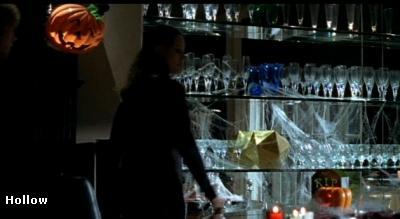 Hollow has striking art direction, cinematography, and costuming. Bright Halloween
oranges and primary colors are set against gleaming surfaces and glass,
strikingly photographed in off-kilter angles and distorting wide-angle
lenses. Hollow has striking art direction, cinematography, and costuming. Bright Halloween
oranges and primary colors are set against gleaming surfaces and glass,
strikingly photographed in off-kilter angles and distorting wide-angle
lenses.
The cold set decor reinforces
the context of a selfish yuppie couple choosing materiality over maternity.
Hollow's
couple live in a sterile world, controlled but unstable, its repressed
lies and secrets ready to collapse with the first intruder.
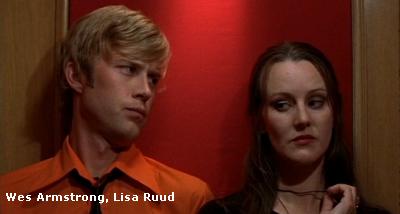 "I shot Hollow.at
a family friend's house," said Soemantri. "My art director came on
board late. She added the red fabric in the elevator to make the
scene more intense. But the interiors were already there. I'd
already put up the Halloween props, the spider webs and spiders. "I shot Hollow.at
a family friend's house," said Soemantri. "My art director came on
board late. She added the red fabric in the elevator to make the
scene more intense. But the interiors were already there. I'd
already put up the Halloween props, the spider webs and spiders.
"I took care of the costuming
myself. The actors mostly wore their own wardrobe that I'd chosen for them. I purchased the bright orange-red shirt for Paul.
"I had a wonderful DP [Scott
Boettle]. We met several times before production to go over the looks
-- every meeting was easy and fast because we were on the same page. Production went very smooth. Hollow was shot over two weekends, Friday and Saturday of each weekend, in 8 hours."
Hollow.was
shot with a super 16mm Arri and edited on Final
Cut Pro.
The film is non-SAG.
Soemantri found her cast by advertising in Backstage. Contrary to conventional film school wisdom, she often casts children and
animals. "I've had nothing but wonderful experiences with them,"
she said. "I love working with children, though it has its pros and
cons. One of the best things is their natural spontaneity and innocence,
in addition to performing their roles. If you're lucky, you get the
best of both -- the 'natural' and the 'acted' -- and an excellent performance."
Soemantri stresses the importance
of the casting process. I don't mean finding a child who's been doing
this since they're a baby (although that never hurts), but to find one
who's receptive and who you can work with closely. You're always going
to work more with children, so you need someone who's not going to tune
you out after five minutes.
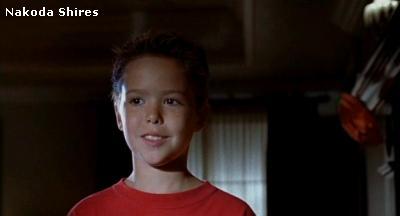 "Nakoda Shires [the ghost
boy in Hollow] was very professional. Although
he was only nine years old, he'd already had plenty of experience doing
commercials. So he was familiar with how a set works and took directions
well. His mom is a total pro. "Nakoda Shires [the ghost
boy in Hollow] was very professional. Although
he was only nine years old, he'd already had plenty of experience doing
commercials. So he was familiar with how a set works and took directions
well. His mom is a total pro.
"An important aspect of working
with children is the parents. Some child actors have incredibly demanding
parents, and I lucked out on that end. The key is to find a parent who's
supportive in the enjoyment and the art of the job, rather than the 'cool'
aspect of their children being 'actors.'"
Hollow has appeared at "more than 25 festivals and screenings" and has won four
awards: New York Independent Film
Festival (Best Horror Short); Big
Apple Film Festival (Best Short Film); Key
West IndieFest (Award of Excellence - Short Film); and Worldfest
Houston International Film Festival (Remi Award - Fantasy/Horror).
"There've been some distribution
possibilities this past year," said Soemantri, "but the deals wouldn't
have been the best for Hollow, so I've held
off on distribution. But I'm always on the lookout for a great distribution
match!"
Born and raised in Indonesia,
Soemantri is an NYU
film school grad who's worked as an assistant director on commercials. More information about Hollow can be found
at Soemantri's website.

* Slinky
Milk
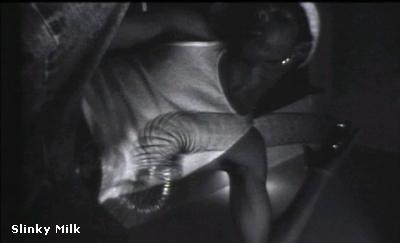 Slinky
Milk is surely the oddest entry this year, a surreal, black &
white short (only 5 minutes) that appears to take inspiration from Un
Chien Andalou. Naturally, there's no "story," but rather,
a series of sex and death images inside a snowbound house. Slinky
Milk is surely the oddest entry this year, a surreal, black &
white short (only 5 minutes) that appears to take inspiration from Un
Chien Andalou. Naturally, there's no "story," but rather,
a series of sex and death images inside a snowbound house.
Oh yes, the film does have
a slinky -- which a young man strokes in mastubatory fashion.
"I often wonder where ideas
come from," said director Jamie Renee Williams to the Investigator. "Slinky Milk's images are the subconscious
interpretation of 20 years of exposure to American horror films. But if there must be any definite influences, John Water's.Pink
Flamingos, in all its absurdity, would be one."
Unsurprisingly,,Slinky
Milk is a product of film school. "Slinky
Milk was born out of a [University of Virginia] class assignment. Our mission was to create a 16mm black & white film that was both horrific
and Mondo. We were to uphold a 'vow of chastity' which included showing
all action offscreen, two shots of the human interior, and radical vantage
points."
So Slinky
Milk.was intended to be Mondo. But
what is Mondo?
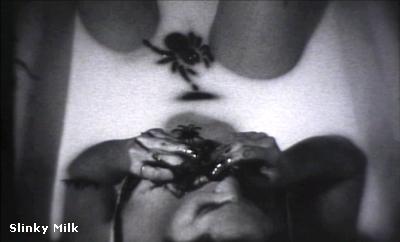 Williams explained, "I say
Mondo, loosely defined, as taking situations and hyperventilating them
to the extreme. I suppose that when mixed with the horror genre,
Mondo can take on the effect of surrealism. But the original intent
was a film of Mondo, or rather horrific and extreme, proportions. Williams explained, "I say
Mondo, loosely defined, as taking situations and hyperventilating them
to the extreme. I suppose that when mixed with the horror genre,
Mondo can take on the effect of surrealism. But the original intent
was a film of Mondo, or rather horrific and extreme, proportions.
"Of course,,Slinky
Milk's genre is open to interpretation. I'm not a film critic
or theorist, but a filmmaker. I can't predict the infinite experiences
people can have with any film -- especially with my films!"
Slinky
Milk's grainy black & white photography supports its surrealist
(ehr, Mondo) aesthetic. Williams thinks it worth the extra effort. "Film requires more thought and planning prior to filming [than does video]
because every second costs. You can't rewind and re-record. Film
takes a certain commitment that video doesn't require. Film doesn't
give the immediate image feedback which video provides, so you must be
able to predict the relationship the film and camera will have with the
light in the room, the colors in the room, the movement in the room.
"And from an artistic perspective,
film still does not compare to video, despite the advent of the 24p video. Film has its own look, its own feel and smell. Black & white
reversal stock is especially nice because of its high contrast. Darren
Aronofsky took advantage of this in.Pi. The black & white aesthetic was perfect for Slinky
Milk as it captures the internal monologues of the two characters."
Although video is cheaper,
Williams added, "Good filmmaking isn't about money. It's about making the
best of what you've got. We had imagination on our set, and that
was key.
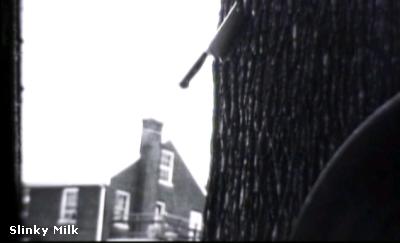 "The entire film was shot
in Charlottesville, Virginia, in the beautiful Blue Ridge Mountains.
Total duration of filming: a mere 12 hours in one day. "The entire film was shot
in Charlottesville, Virginia, in the beautiful Blue Ridge Mountains.
Total duration of filming: a mere 12 hours in one day.
And that snow you see --
paid
for by the graces of a good old fashion Virginia winter."
Williams recently graduated
the University of Virginia with a B.A. in Anthropology. "But I studied film for the last two
years of my university career under the auspices of [Slinky
Milk producer] Kevin Jerome Everson, filmmaker immaculate," she
adds. "I'm now living in Okinawa, Japan for a year or two, until
I apply to film school. Films will be done here, absolutely!"
Slinky
Milk screened at the University of Virginia's 2005 Salmagundi
Film Festival. Apart from that home turf performance,
the Tabloid Witch Honorable Mention is Slinky Milk's
first
official recognition!

*
Cadaverous
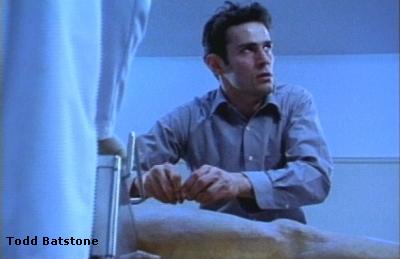 Necrophobia is the theme
of Michael Fiore's Cadaverous, the tale of
a medical student whose grades suffer because he can't stand the sight
of the corpses he's forced to study and dissect. Necrophobia is the theme
of Michael Fiore's Cadaverous, the tale of
a medical student whose grades suffer because he can't stand the sight
of the corpses he's forced to study and dissect.
Confronted by a stern professor,
the student tries to overcome his fear by "familiarizing" himself with
the dead.
"Cadaverous went through several incarnations while I was an [undergrad film] student at
NYU," said Fiore to the Investigator.
"The original script was very
campy, but I didn't want to make a campy B-film. Camp is easy to
make. I wanted to make something with a balance of humor, drama,
and creepiness. [Film school] was a nerve-racking
period in my life as the future was uncertain regarding my upcoming graduation
and a film career ahead. I wanted to make the film about fear and
uncertainty.
"When I was in high school,
I had a science teacher that I bumped heads with all the time. I'd
tell him that I didn't need to waste my time with his class, as I was going
to be a filmmaker. The teacher's response was, 'You'll never be a
filmmaker ... you won't amount to anything.'
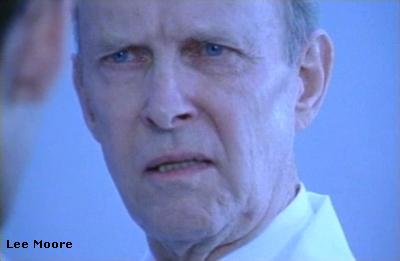 "Between that moment in
my life, the challenges of film school and the fear of failure, the premise
of Cadaverous developed. In it, Professor
McCarthy (Lee Moore) tells the necrophobic medical student that he has
'nothing to offer the medical profession.' "Between that moment in
my life, the challenges of film school and the fear of failure, the premise
of Cadaverous developed. In it, Professor
McCarthy (Lee Moore) tells the necrophobic medical student that he has
'nothing to offer the medical profession.'
"Cadaverous.was
also inspired by the works of talented filmmakers who've come before me.
Hitchcock stands out in mind. And Robert Zemeckis, Rod Serling, and
David Fincher. Fincher's The
Game looks precise and pre-planned; every shot is necessary. I went into production with the entire film storyboarded and the final
film matches those boards almost identically. This was helpful with
our limited time and budget."
Despite being an NYU student,
Fiore shot his film at Wagner
College in nearby Staten Island. "My parents attended
the school and met there. The college was extremely supportive and
gave us their Main Hall for the duration of their Spring Break. We
had complete control over the environment, which was very helpful."
To find a cast, Fiore advertised
in Backstage. "I knew I wanted a certain look for my leads, especially the gaunt and
nervous medical student. When I sifted through the hundreds of headshots
I'd received, Todd Batstone and Lee Moore grabbed my attention.
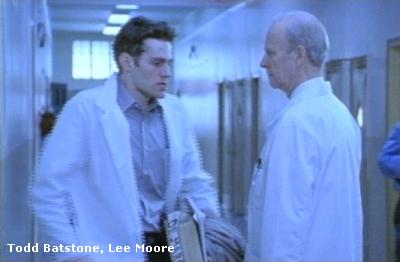 "I saw about 50 actors for
each role. Funny enough, Todd and Lee were the first two to read
for their roles. I knew immediately that, based on look and now performance,
they were my guys. "I saw about 50 actors for
each role. Funny enough, Todd and Lee were the first two to read
for their roles. I knew immediately that, based on look and now performance,
they were my guys.
"I continued to meet other
actors, but I knew down deep that I'd found my leads."
Cadaverous.was
shot on 16mm film. "I edited over 4 to 6 weeks, working 12 hour days,
on an Avid Media Composers," said Fiore. Upon
graduating NYU, he spent the better part of a year completing post-production.
Cadaverous has aired on The
Sci Fi Channel and KQED-TV in San Francisco. It was screened and honored at "over 25 festivals."
Fiore has since worked as
editor on Jim
Breuer: Heavy Metal Comedy, American Dummy,
and Everyday Hero, and has directed commercials
and promos for A&E Television Networks. He's slated to direct
a low-budget feature for Moderncine this fall.
END
OF PART ONE. GO TO PART TWO.
Copyright 2005 by HollywoodInvestigator.com


|
